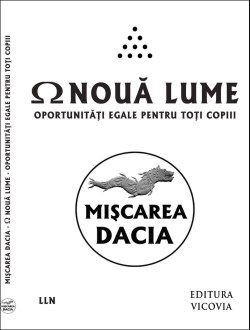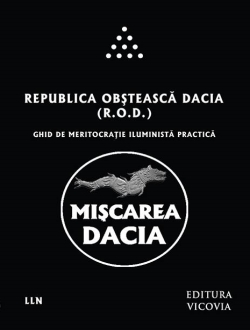 Vă invit să vă alăturaţi grupului Facebook Mişcarea DACIA, ce-şi propune un alt fel de a face politică!
Vă invit să vă alăturaţi grupului Facebook Mişcarea DACIA, ce-şi propune un alt fel de a face politică!Citiţi partea introductivă şi proiectul de Program, iar dacă vă place, veniţi cu noi !
O puteţi face clicând alături imaginea, sau acest link
Archive for Agosto, 2019:
What Constitutes Existence?

What Constitutes Existence?
Many philosophers and religious thinkers have proposed endless ways to describe the basic nature of existence. So, let’s play the God Game. If you were God, which of the following options would you have chosen? We shall take an incredible tour of the multitude of options available to God.
Materialism: “The world … is corporeal, that is to say, body … and every part of the universe is body, and that which is not body is no part of the universe.” – Thomas Hobbes
Idealism: Everything is mental; the material world is ultimately mental.
Panpsychism: all matter has a mental aspect; mind is everywhere; all entities have a unified centre of experience; all entities have their own unique point of view (perspective); all parts of matter involve mind, or more holistically, the whole universe is an organism that possesses a mind; the idea that all matter is imbued with some (greater or lesser) form of consciousness.
The distinction between idealism and panpsychism is that the latter treats everything as mind or as containing mind whereas the former treats things as content of the mind. In panpsychism, a rock, for example, has a mind (albeit rudimentary and unconscious) whereas in idealism, a rock has no independent material existence but is merely a mental phenomenon – an idea in a mind. In panpsychism, a rock doesn’t vanish if the mind perceiving it dies. In idealism, the rock is dependent in the mind’s perception of it, so “dies” when the mind dies. In other words, panpsychism allows for the objective existence of things whereas idealism is purely subjective (all apparently objective things are contained within subjective minds, and do not exist without the subjective minds that sustain them).
Illuminism agrees with idealism that mind and not matter is the basis of reality, but Illuminism is fundamentally an expression of panpsychism. “Panpsychism is the view that the basic physical constituents of the universe have mental properties” — Thomas Nagel
Dualism: the view that mind and matter have independent existence and neither is reliant on the other or originates from the other.
Panpsychism is sometimes seen as dualist since it attributes mind to matter, thus acknowledging the objective existence of matter, and regards everything as having both mental and physical properties. In Illuminism, mind and matter are both mathematical and matter is in some sense “solid” mind i.e. matter is an expression of mind. It has different mathematical characteristics: above all the number zero is excluded from material existence yet defines mental existence.
“In the matter of consciousness, the position of Empedocles may be defined as a rigorous panpsychism. In his view, which seems to be shared to some degree by most early Greek thinkers, the faculty of feeling, perception, and thought does not constitute a prerogative of men and animals, but is assumed to be distributed generally throughout the natural world. From this point of view, there is really no such thing as inanimate nature. The character of any object is conceived of as a vital urge that may be described in terms of thought and volition. This conception is analogous to the ‘animism’ which is said to characterise the attitude of many primitive peoples in their dealings with nature. But the animism of Empedocles is scarcely primitive: it is explicitly formulated as a philosophic principle. He ends the poem On Nature with a warning to his friend Pausanias that the truths communicated must be carefully borne in mind, or else they will leave you all at once, when their times come round, yearning after their fellows, to return to their own dear kind; for know that all things have intelligence and a share in thought. This statement implies a systematic parallelism between physical objects and mental conceptions. Not only does everything have a share in thought, but every thought is treated like a thing. Apparently Empedocles recognizes no radical distinction between the two, for the constituents of the physical world and our perception of this world are described in the same terms:
By earth we behold earth, by water water,
by air bright air, by fire, ravaging fire,
love by love and strife by gloomy strife.
For out of these are all things compounded
and fitted together and with these do they think
and feel pleasure and pain.”
— Essays in Ancient Greek Philosophy, Edited by John P. Anton with George L. Kustas
Reductive panpsychism reduces all material properties to mind.
Reductive physicalism does the opposite and reduces everything to matter.
Reductive physicalism is essentially materialism: everything in the world can be reduced analytically to its fundamental physical, or material, basis. All mental states and processes can be reduced to physical states and processes. All organic and inorganic processes can be explained by reference to the laws of physical nature.
Illuminism, on the other hand, reduces everything, mental and material, to mathematics and asserts that all organic and inorganic processes can be explained with regard to mathematical laws of existence.
Neutral monism: this is the view that the mental and the material are two different perspectives of the same underlying thing, which is itself “neutral” i.e. neither physical nor mental. So, this stance rejects the view that the mental and the physical are two fundamentally different things and asserts that there is only one fundamental “stuff” in the universe (hence why it’s a monism). Neutral monism was first propounded by Spinoza who proposed that mind and matter were two attributes of God (the underlying monism), although Spinoza’s view might better be called dual-aspect monism:
“In strict parlance, neutral monism should be distinguished from dual-aspect monism, which holds that all existence consists of one kind (hence monism) of primal substance, which in itself is neither mental nor physical, but is capable of distinct mental and physical aspects or attributes that are two faces of the same underlying reality in the one substance. … The theory’s relationship to neutral monism is ill-defined, but one proffered distinction says that whereas neutral monism allows the context of a given group of neutral elements to determine whether the group is mental, physical, both, or neither, double-aspect theory requires the mental and the physical to be inseparable and irreducible (though distinct).” — Wikipedia
Schopenhauer, like Spinoza, is a dual-aspect monist. In Schopenhauer’s philosophy, there is only one substance (Will), but it manifests itself physically (phenomenally) and mentally (noumenally), with each being the flip side of the other.
Illuminism might be considered a dual-aspect monism. Mathematics is the ground of existence (the monism) and takes the form of infinite mathematical points, inbuilt with the laws of mathematics. Since a monad is a rudimentary mind, mind and mathematics are intimately connected. Mind can be considered as subjective mathematics – how it feels to be a mathematical entity; the inside perspective; the inner experience – while matter is objective mathematics, subject to the laws of what humanity calls science. Subjective mathematics is the within of mathematics while objective mathematics is the without.
It is a primary axiom of Illuminism that all of the fundamental units of existence are subjective when experienced internally and objective when viewed externally. Everything is a subject to itself, but an object to everything else. If a subject acquires a body (as in a human being) then that constitutes its objective presence in the world, while the mind is its subjective presence.
William James also developed a neutral monist view, and is perhaps the classic expression of that view. Bertrand Russell said, “James’s view is that the raw material out of which the world is built up is not of two sorts, one matter and the other mind, but that it is arranged in different patterns by its inter-relations, and that some arrangements may be called mental, while others may be called physical.”
Panpsychism can be readily combined with neutral monism. Illuminism is the stance that mathematics is the basis of mind and matter, hence mathematics is the neutral monism in that sense. Each mathematical point is regarded both as a unique mind and as fundamental building block of the material world. (Many of these definitions flow in and out of each other or form a continuum rather than clear-cut distinctions.)
Holism: the view that the whole Universe is an organism that possesses a mind. Equivalent to a certain view of panpsychism.
Animism (from Latin anima “soul, life, mind, breath”; similar in concept to Greek words such as psyche and pneuma): the view that all things have a soul; all animate and inanimate objects possess individual, innate souls; the hypothesis first advanced by Pythagoras and later promoted by Plato that an immaterial force animates the universe (the World Soul).
Animism is the belief that non-human entities are spiritual beings, or embody a life-principle. In this view, there is no separation between the spiritual and physical worlds. Souls/spirits exist not just in humans, but also in all other animals, plants, rocks, and all natural phenomena. Thunder and lightning have souls. Mountains, rivers, woods, stars, planets, galaxies, black holes – they all have souls. The universe is a vast network of ensouled creatures. Personalized supernatural beings (or souls) occupy all objects and govern their existence. Just as a human body is said to have a soul, all bodies of any type at all (including inorganic bodies) also have souls, although of very different mental character. Animism is the view that spirits inhabit the universe in all of its parts.
Extreme animism attributes souls even to abstractions such as words, true names (which have tremendous power in the occult world), and mythological symbols. Shinto, Hinduism, Buddhism, Taoism, Pantheism and Neopaganism all have significant animistic tendencies.
Illuminism is a type of animism since it teaches that living (but unconscious) monads are the source of everything in the world. However, while animism assigns consciousness to all things, Illuminism does not. Illuminism is about the unconscious mind evolving towards consciousness as its highest manifestation.
In Illuminism, unconscious monads are the building blocks of existence. Existence is predicated on fundamental units of mathematical life. Ontological mathematics is alive. All mathematical functions and signals produce an inner experience in the living monads affected by them.
Animism was the first religious system conceived by the human mind and, when equated with ontological mathematics, becomes supremely powerful. However, when associated with primitive beliefs and superstitions, it degenerates into the monotheistic Abrahamic system that there is one single and all-unifying animating force in the universe – God, the Creator.
Abrahamism is animism taken to its extreme position in terms of conscious design of the universe. Illuminism is animism taken to its extreme position in terms of unconscious, teleological evolution of the universe.
Science disregards animism completely, and is thereby incapable of explaining how life comes from non-life. It should be noted that life/non-life dualism is just another way of talking about the mind-body problem. Life and mind are effectively synonymous. You are alive if you have a mind, even if that mind is rudimentary and unconscious.
Illuminism solves mind-body dualism by demonstrating that the body originates in mind (i.e. there is no separate material world). It solves the life/non-life problem by demonstrating that everything is alive (i.e. there’s no kingdom of dead things that are somehow assembled like Frankenstein’s monster into living beings). Existence MUST be monistic. There can be no existential dualism.
Science claims to be a monistic materialism, but philosophically it is radically dualistic since it cannot offer any viable mechanism to account for how mind comes from non-mind or life from non-life. Although science claims that life and mind are materialistic phenomena that originate in more elemental materialistic phenomena, in reality the gulf between mind and non-mind and life and non-life is infinite.
Descartes’ philosophy failed because of its dualism. Either matter must be fully explained by mind, or mind by matter. Illuminism is the proof that matter is ultimately mental and not physical. Science, on the other hand, has wholly failed to prove that mind is ultimately material.
Excerpt from The God Game
Mike Hockney
Artwork by Yuliya Zelinskaya
Tags: Animism, Descartes, Dualism, Holism, Idealism, Illuminism, Materialism, Monism, Panpsychism, Physicalism, Science
The Cloning of God

The Cloning of God
God had an inner compulsion to externalise himself: to make a consciousness outside and beyond himself, and through this otherness to come to full consciousness.
Hegel, one of the greatest grandmasters of the Illuminati, said, “The divine Idea is just this: to disclose itself, to posit the Other outside itself and to take it back again into itself in order to be subjectivity and mind/spirit.”
Consciousness, including that of God, requires interaction with otherness if it is to develop. God is compelled to create otherness – to externalise himself – and through a study of that otherness we can gain sure knowledge of God.
Hegel criticised conventional Western religion on the grounds that it separates God from the universe, and makes all of his attributes independent of the universe. God, according to the traditional view, would be exactly the same whether or not anything else existed. His nature wouldn’t alter in the slightest even if there were no universe and no other creatures. Hegel fiercely attacks this view. If God had no inner need to create anything else then why did he? Is he capricious? Was he bored? Curious? None of these make any sense in relation to a perfect God without deficiency. God is entirely self- sufficient and needs nothing else according to the tenets of mainstream Western religion. Hegel said, “If God is all sufficient and lacks nothing, how does he come to release Himself into something so clearly unequal to him?”
No Christian, Jew or Muslim can answer why God creates the world when he has no need to do so. If he does it for a reason such as wanting to spread his love then it implies that he has a need to do that, yet God, by definition, needs nothing. If he does it because he wants to be obeyed and worshipped then that also indicates deficiency on his part. If God is truly self- sufficient, it is impossible that he would ever have felt the need to create anything. Therefore God is not self-sufficient. Therefore a God of whom it is claimed that he is self- sufficient cannot exist. God creates otherness because he must. He has no choice. He is compelled. Creation is an act of inner necessity. God needs others as much as they need him. Anyone who doesn’t understand that single truth can never understand God. They will always believe in a fantasy.
God created many things as he evolved – a dazzling realm fashioned from light – but none of them gave him what he needed: an otherness comparable to himself. Eventually, after endless experiments, God succeeded in cloning himself. The clone was the being that is now known as Lucifer, Son of God, the Angel of Light, the Morning Star, Lux Mundi, the Light of the World.
God, through his interaction with Lucifer, became fully self-conscious, as did Lucifer. Between them, they created the first language, the divine language. Then Lucifer wanted a brother as a companion and God granted his wish. The second son of God was a fateful being. His original name was Paracletus, meaning “the Comforter” or “one called to help” because he was to be Lucifer’s brother and friend. But religion knows him by his later name of Satanel, then simply Satan. Satan means “accuser/adversary”. It will be explained below why Paracletus, second son of God and beloved brother of Lucifer, became the sworn enemy of his father and brother and acquired his dread new name.
Satan’s fatal flaw was “hyperephania” – extreme pride. Afflicted by doubts about himself, lacking self-esteem, in awe of his father, envious of his radiant brother, unsure of his identity, Satan compensated by cultivating an exaggerated ego. After an age, he believed himself superior to Lucifer and even God. He resented their relationship and was jealous of it. He resented being the youngest and least powerful. Resentment became hate. Hate became action. That action was rebellion. He stood as the adversary of God and Lucifer. He accused them of plotting against him. He opposed all of their plans.
Having created Lucifer and Paracletus, God provided his sons with the secret of how to clone themselves. The clones of the two sons were the beings now known as angels. The realm of light became populated by many beings of light: God, his two sons and the choirs of angels. But the angels were loyal to their respective creators and reflected their natures. Satan’s angels were infected with his discontent.
Satan and his army of angels rebelled against God, Lucifer and their loyal angels. The struggle was long and furious, but Satan and his followers lost and fell. They were banished from God’s realm, being cast out into darkness where the light of God never penetrated.
Satan wanted his own realm where he was the sole master. He discovered the secret of matter and fashioned a rival universe of matter rather than light. This was the universe of the Big Bang – our universe. “Let there be light,” Satan announced as he brought this universe into existence: a mockery of God’s light. Satan is the creator and ruler of our universe of the Big Bang, and he’s assisted by his rebel angels – called the archons, groups of whom were given regions of the universe to rule on Satan’s behalf. 144 archons are assigned to earth. They are responsible for most of the secret history of earth. They are opposed by two groups within that secret history: the Illuminati (consisting of approximately 6,000 people i.e. a similar number to that of the Old World Order), and the small group that created the Illuminati but stands outside of the society, just as the archons stand outside the Old World Order. That small group consists of 36 angels of Lucifer.
The Illuminati and the Old World Order are mirror images. Both groups know the secret history of earth, and the strange and fateful struggle that takes place behind the scenes and to which the rest of humanity is mostly oblivious.
Satan was almost as bright as Lucifer in his earliest days, but he grew repelled by light and made himself dark. He became “darkness visible” to use John Milton’s immortal phrase. He is truly the prince of darkness, yet it must never be forgotten that he is the Son of God and contains the divine spark.
Through Satan, evil entered the universe. The birth of evil is not difficult to understand. It is a product of a damaged self-consciousness, of low self esteem finding a way to over- compensate. It is exactly the sort of situation with which Freud and Jung would be familiar. Why should gods be any different from humans? We are made in their image.
Excerpted, page 216
© The Illuminati’s Secret Religion
Artwork by Asteri-A
Hyperian History Of The World (17th Century, Part 2)
Hyperian History Of The World (17th Century, Part 2)
The 17th Century saw the true rebirth of philosophy; philosophy finally freed from the constraints of christianity. But the century also saw the birth of modern science, which would move even further away from the ideas of religion.
The heliocentric theory of the universe developed by Copernicus in the previous century had, of course, been utterly rejected by the church, and many other thinkers and intellectuals had trouble accepting this idea which ran contrary to centuries of thought. However, slowly but surely, the idea crept into the minds of scientists who began to rethink the very way in which they might understand the universe.
Philosophers such as Descartes and Spinoza tended to think in a more mathematical way, thus developing rationalist systems more akin to the ancient greek thinkers. Scientists (or ‘Natural Philosophers’ as they were known then) thought differently. Perhaps scientists were more extroverted individuals in general, but, for whatever reason, rather than thinking rationally within their own minds, scientists looked outwards into the physical world around them, basing their ideas merely on their own observations.
The man often regarded as the father of modern science was the Italian Galileo Galilei. Galileo began to make observations and to perform experiments to support his theories. Experiments sometimes revealed that long standing theories about physics were in fact incorrect. For example, Aristotle had said that an object’s weight determines the speed at which in falls to the ground. Given the reputation of Aristotle, his theory was accepted and never tested for well over a thousand years. Galileo, however, decided to experiment. There is a story (probably not true) which tells of Galileo dropping canon balls of varying sizes from the top of the leaning tower of Pisa and measuring their speed. It is more likely that Galileo actually carried out a more simple experiment but, regardless, the results showed that, no matter the weight of the balls, they all fell to earth at the same speed, contrary to what Aristotle had said.
The fact that a simple experiment could easily prove wrong an idea which had been accepted for such a long time showed that this new, experimental method of science could achieve great things. Galileo’s observational method also proved successful. Thanks to the invention of the telescope, scientists and astronomers could get a much closer look at the heavens and thus could begin to better understand what was going on up there. Using a telescope, Galileo observed the planet Jupiter and realised that there were several smaller bodies which seemed to be orbiting around the planet. This was a momentous discovery, as it seemed to vindicate the heliocentric theory of Copernicus, as well as the complex cosmology of Giordano Bruno. If other planets have moons orbiting them, then the Earth really ceases to be anything special in the universe. We are simply one planet of many orbiting the sun, each other planet having its own smaller system of orbiting moons.
As a result of his observations, Galileo accepted the heliocentric model, which was still controversial. His writings about it attracted the church’s inquisition who tried him and, in 1633, found him to be suspect of heresy. Knowing what had happened to Giordano Bruno, Galileo decided to recant his ideas, thus sparing his life, but he remained under house arrest until his death in 1642. The church still had some power, but they were weakening. Galileo was not killed as Bruno had been, and, despite his recanting, his heretical ideas could not be stopped and began to spread and become more and more accepted. The church were losing their grip and they couldn’t very well keep everyone under house arrest.
Galileo’s methods of observation and experimentation brought about a revolution for science, yet his theories still amounted to little more than speculation. Galileo seemed to be suggesting that the universe was like some kind of huge machine, which operated according to certain laws. But Galileo was simply observing these laws in action, he was not precisely stating what the laws were. More rigour was required for science to get really serious. The rationalist philosophical system of Descartes had a decidedly mathematical underpinning, given that Descartes was a brilliant mathematician. Mathematics was the very quintessence of rationalism that seemed to have little to do with the observational, experimental methods of scientists such as Galileo. However, in a bizarre twist of fate, one scientist turned precisely to mathematics in order to give science much more rigour. This was Isaac Newton.
Newton is a rather strange figure in this history. Despite science seeming to move away from christianity, and Newton playing such an important role in it, he nonetheless remained almost fanatically christian for all his life. In his religious writings, Newton revealed that he regarded himself to be almost like a religious prophet, sent by god to reveal the workings of the universe to humanity. As such, despite the huge impact he had on science, Newton’s theories, from the beginning, were tainted by religious ideas. Rather than build a system of truth from the ground up as did Descartes and Spinoza, or to draw conclusions based upon observations as did Galileo, Newton presupposed certain religious ideas (such as the existence of the christian god) and skewed his theories so as to ‘prove’ those ideas to be true.
For example, Newton is often regarded as the man who ‘discovered’ gravity. Yet when Newton was asked how gravity could possibly work instantaneously even over vast distances, he simply stated that Gravity was god’s will at work, and god can do anything he wants! This hardly seems like science at all, yet Newton is revered by scientists all over the world to this day.
Ultimately, Newton’s theories amount to simple approximations about the physical universe. Being only approximations, these theories can be expressed with rather simple mathematical formulas, yet these formulas give Newton’s science a greater sense of rigour than any scientist had given before. As such, Newton’s science became accepted the world over and was not challenged for centuries, despite his theories being only approximations and despite many of his theories relying on religious ideas taken only on irrational faith!
Despite science seeming to free humanity from the clutches of christianity, Newton’s science has in fact set humanity back for centuries. Newton’s theories were literally too good to be true, yet few were intelligent enough to realise this. Whilst it was a great step forward to mathematise one’s theories, this only works if one’s theories are correct to begin with, and Newton’s simply weren’t. However, in Newton’s own lifetime, there was one who saw through him, one who developed a philosophy based on theories which were correct but who, despite his best efforts, failed to mathematise his theories, not because he lacked the skill, but because his theories were so complex and ahead of their time that the mathematics required to explain them simply hadn’t been discovered. It is this individual who ought to be celebrated as humanity’s greatest genius, but we shall return to him in a later chapter of this history.
– Brice Merci

Mind Control
L-Y-R-I-C-S:
”Truth sparks revolution and is therefore labelled violent. Condemned to the silent movement of rebels who are defiant. Six eyed in the house of Madball Rev Up Controlled minds Lead the blind You cannot control mine You’ll never control mine The question is for you The youth What will you do With all this proof The information’s all there Educate yourself if you dare You want the truth You want the truth Rev up Rev up You want the truth It’s within you Rev up Rev up Keep looking searching See what you find Don’t fall for nothing Don’t fall in line Use your own mind To change their old minds You want the truth You want the truth Rev up Rev up You want the truth It’s within you Rev up Rev up Don’t cut the root But we need evolution These troubled youth Need a solution Most of you Suffer from delusion You want the truth Start a revolution Yeah yeah Start a revolution Yeah yeah Start a revolution Yeah yeah Start a revolution Yeah yeah yeah Don’t cut the root But we need evolution These troubled youth Need a solution Most of you Suffer from delusion You want the truth Start a revolution Yeah yeah Start a revolution Yeah yeah Start a revolution Yeah yeah Start a revolution Yeah yeah yeah yeah”
FREEDUMB STATE OF MIND
L-Y-R-I-C-S: FREEDUMB STATE OF MIND
Remember the time
When justice wasn’t blind
When system wasn’t rotten
Whole families forgotten
Now it’s time to wake the fuck up
…time to wake the fuck up
These days we live
In world where nothing’s free
Where nothing’s really sacred
Whole nations thrive on hatred
Greed, possesion, fear, deception,
Staged destruction, to boost production
…a freedumb state of mind!
They like us silent
– freedumb, freedumb
That’s why the call it
— a freedumb state of mind
They like us silent – freedumb, freedumb
Now it’s time to wake the fuck up
…time to wake the fuck up
Tags: freedumb











